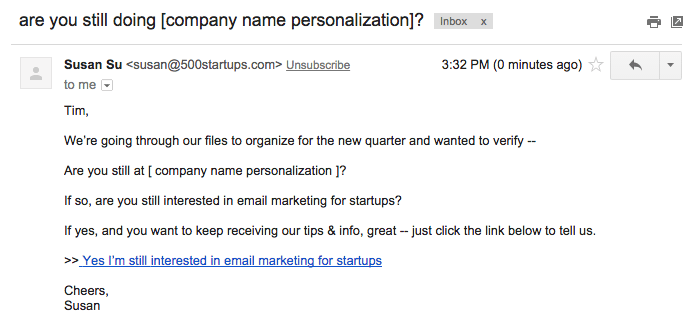January 14, 2016
5 Email Marketing Templates From 500 Startups With Behavioral Triggers
_Today’s guest post is from Susan Su, a partner at 500 Startups, where she specializes in growth marketing advising (specifically on email) for portfolio companies. She is also the creator of _Email For Startups. Email For Startups is a project I created after working with hundreds of startups and founders both within the 500 Startups portfolio and outside of it. I was seeing the same roadblocks come up over and over again. Every time, a few simple tweaks would end up making a huge difference – conversion rates that doubled, open rates that jumped double digits on seemingly ‘stale’ lists, cold prospects that suddenly started to reply and actually request demo meetings. The changes seemed subtle, but they were based on 7+ years of practice and mistakes as a copywriter and email marketer at AppSumo, I Will Teach You To Be Rich, and Inside Network (a tiny bootstrapped content business that resulted in a $14M exit). As much as I love working with founders and startup marketing teams – and seeing their eye-popping results – I got tired of saying the same stuff over and over again. So I decided to put it all together in one easy place, for a teeny, tiny fraction of what it would cost to hire a decent email marketer (let alone a great one). Today, I’m sharing a small sample of what I’ve put together in my Email For Startups Ultimate Email Playbook. I hope you get TONS of juice from these few templates. Feedback I’ve received from working with hundreds of startups on their email marketing is usually along the lines of: “Our open rate went from 37% to over 50% and conversions doubled, after we implemented your version.” “We learned so much from you in 15 mins what would have take us weeks to figure out. It was like “email marketing wisdom” delivered in a capsule.” “Our welcome email just jumped 12% in its open rate… now people are actually ready to activate.” … and I want that for you. To that end, I wholeheartedly invite you to squeeze these five templates for all they’re worth. And if you like what you see here, consider getting the full Ultimate Email Playbook, and/or sharing the landing page with your friends: http://emailforstartups.com/ultimateplaybook With that, let’s get into the emails!
Template #1: Welcome emails that keep users coming back for more
Your welcome email is extremely important. You should be aiming for a 60%+ open rate on this email – if users don’t open your welcome email, you’ve basically lost them. Your welcome email serves two main purposes:
It trains your subscriber to OPEN messages from you. For people to open future emails from your ‘from’ name, they need to be accustomed to taking the “open” action whenever they see your name in their inbox.
It sets expectations for what’s coming up next in your funnel. You’re going to tell them what’s coming AND what actions they should take when they receive your upcoming messages.
This is all related to training them to open your emails and take actions once they do, and has to do with the psychological triggers of Commitment and Consistency (I’m the kind of person who who opens emails from you, aka I’ve established that habit, and now I want to be consistent to it), and Liking (I like you, you’re familiar to me and “on the same side”). The welcome email is all about getting the open and ideally even a reply. This is about training your subscriber, as I said before, but not only that. You’re also training your subscriber’s email service to prioritize emails from you, and not send your messages to spam or “promotions.” Here’s a welcome email from StudySoup as an example:  Special thanks to Sieva and StudySoup for letting loose on their email funnel, and for letting me share their campaign here. Why this email is effective… 1. It sets expectations, “in the next few days, I’m going to send you…” Rather than being a “sleazy marketer” who tries to pull a bunch of marketing ninja tricks on them, Sieva explains that he’ll be sending some valuable and interesting information in the coming days aimed at helping them to understand and use your product. 2. It’s a plain text email that excludes images, because images increase the likelihood of the email getting filtered into Priority Inbox or even spam. 3. It has calls-to-action. The CTAs aren’t big, bright buttons (they don’t have to be). In your case, you could ask your recipient to reply to your message answering a brief question (“What brought you to the site?” “What’s your most pressing business question related to email marketing?”). Or, link your CTA to an activation flow – getting your recipient back to your site or app to finish signing up, create their first project, or however you’ve defined your primary activation threshold. Welcome emails are REALLY important because they set the tone, and if you don’t get it right at this stage, it can be hard to recuperate your losses later on in your funnel.
Special thanks to Sieva and StudySoup for letting loose on their email funnel, and for letting me share their campaign here. Why this email is effective… 1. It sets expectations, “in the next few days, I’m going to send you…” Rather than being a “sleazy marketer” who tries to pull a bunch of marketing ninja tricks on them, Sieva explains that he’ll be sending some valuable and interesting information in the coming days aimed at helping them to understand and use your product. 2. It’s a plain text email that excludes images, because images increase the likelihood of the email getting filtered into Priority Inbox or even spam. 3. It has calls-to-action. The CTAs aren’t big, bright buttons (they don’t have to be). In your case, you could ask your recipient to reply to your message answering a brief question (“What brought you to the site?” “What’s your most pressing business question related to email marketing?”). Or, link your CTA to an activation flow – getting your recipient back to your site or app to finish signing up, create their first project, or however you’ve defined your primary activation threshold. Welcome emails are REALLY important because they set the tone, and if you don’t get it right at this stage, it can be hard to recuperate your losses later on in your funnel.
Template #2: Activation emails that get people started fast
Activation emails aren’t the same as welcome emails. Yes, you should always use your Welcome email to try and activate people ASAP. But that’s not their only job. Your activation emails’ ONLY job is to help people reach your activation threshold – however you’ve defined it. Not to follow you on social media. Not to get a reminder of their account or login details. Not to learn more about your brand or business announcements. ONLY to hit that activation threshold, however you’ve defined it. Here’s an activation email template to illustrate:  This activation email is a basic, tight “conversion” email where every word of copy is oriented towards getting people to take specific action to activate. Activation email templates work best AFTER a welcome message sets the stage, and usually lead either directly to the product, or to an educational onboarding flow.
This activation email is a basic, tight “conversion” email where every word of copy is oriented towards getting people to take specific action to activate. Activation email templates work best AFTER a welcome message sets the stage, and usually lead either directly to the product, or to an educational onboarding flow.
Template #3: Reach the 60% of non-openers on your email list
The best open rates on a decent sized list will be in the 30% to 40% range, maybe up to 50% if you’re really amazing. A 40% open rate on a 5-figure-plus list says great things about your list-building and email marketing skills, but what about the money you’re leaving on the table? 60% is a lot of subscribers to completely miss out on your carefully crafted psychological triggers and conversion optimized copy. In my experience, you can reach up to 25% more of your list just by sending one, two or three more times. This is the exact template that I—and some top emailers I know—used to tap into the 60% of our list that our main email didn’t reach.  Why it works… 1. Starting the subject line with “Fwd” creates a powerful curiosity gap, plus increases personalization and priority (someone thought to forward a message to them). 2. There’s an element of social proof and exclusive/scarcity by using the parenthetical text “mobile devs only please” **3. It’s personal. **“I want to make sure you got a personal invite from me…”
Why it works… 1. Starting the subject line with “Fwd” creates a powerful curiosity gap, plus increases personalization and priority (someone thought to forward a message to them). 2. There’s an element of social proof and exclusive/scarcity by using the parenthetical text “mobile devs only please” **3. It’s personal. **“I want to make sure you got a personal invite from me…”
Template #4: Reactivate your dormant list of subscribers
Most businesses don’t do reactivation. At all. In looking through my vault of top emails – including some of my email marketing heroes – this came as a shocking observation. And yet, somewhere around 60% of subscribers on email lists around the world are dormant, meaning those people haven’t opened an email from that list in 6 months or a year. It seems obvious, but the reality is that very few businesses are proactively re-engaging dormant subscribers. You want to send reactivation messages to this dormant segment of your list to move them up the food chain. Remember these key things about reactivating your list:
**You have nothing to lose. **These subscribers are dormant already.
Seek to understand why and when subscribers became dormant so that you can address your dropoff cliffs through remarketing via email and other channels.
Never delete subscribers because you can always use the emails for retargeting.
Here’s an example of a reactivation email:  Let’s break down why it works… **1. The subject line uses company name personalization **(one of my favorite types). When we see our own first name in a subject line, we think… oh, it’s marketing. I don’t know about you, but no friend of mine has ever written me an email with a subject line starting with “Susan…” 2. It’s also really hard to say no to verifying something. _“We’re going through our files to organize for the new quarter and wanted to verify…” _If it’s wrong, we get an itchy urge to correct it. If it’s right, we want to reaffirm it. It also doesn’t seem like it’s a sell. 3. It includes a benefits-focused topic. _“Are you still interested in email marketing for startups?” _gages whether or not the client is still a potential lead. 4. The “>>” draws extras extra attention to the verification landing page that then opts the subscriber into a re-engagement funnel.
Let’s break down why it works… **1. The subject line uses company name personalization **(one of my favorite types). When we see our own first name in a subject line, we think… oh, it’s marketing. I don’t know about you, but no friend of mine has ever written me an email with a subject line starting with “Susan…” 2. It’s also really hard to say no to verifying something. _“We’re going through our files to organize for the new quarter and wanted to verify…” _If it’s wrong, we get an itchy urge to correct it. If it’s right, we want to reaffirm it. It also doesn’t seem like it’s a sell. 3. It includes a benefits-focused topic. _“Are you still interested in email marketing for startups?” _gages whether or not the client is still a potential lead. 4. The “>>” draws extras extra attention to the verification landing page that then opts the subscriber into a re-engagement funnel.
Template #5: Land a 15-minute demo with B2B lead
Email is still the #1 way to reach clients in a business-to-business scenario. Even if you’re closing your deals in person or via phone, email is an indispensable part of your nurturing strategy. One of the main goals of B2B email marketing is to activate your prospects into leads with whom you can have a phone conversation or demo, like so…  Why this email works… 1. The subject line leverages social proof and aspiration by citing big name competitors and/or peers in the prospect’s category. 2. The opener leverages the psychological triggers of Liking and Authority. _“I’m Agustina, a longtime fan of [ PROSPECT ] and CEO at GlamST.” _ 3. There’s a specific call-to-action at the end, “Would you be available next Wednesday afternoon or Thursday for a 15-min demo to see how it works?”
Why this email works… 1. The subject line leverages social proof and aspiration by citing big name competitors and/or peers in the prospect’s category. 2. The opener leverages the psychological triggers of Liking and Authority. _“I’m Agustina, a longtime fan of [ PROSPECT ] and CEO at GlamST.” _ 3. There’s a specific call-to-action at the end, “Would you be available next Wednesday afternoon or Thursday for a 15-min demo to see how it works?”
The Ultimate Email Playbook for Startups
Although you can’t create a masterpiece of email marketing by plagiarizing someone else, you CAN copy ‘best-in-class’ skeletons to give your own unique message a head start. It’s still up to you to plug in your own compelling content – no small task – but having a formula and a shape that’s proven to work helps a lot. This is my goal behind The Ultimate Email Playbook. Not to give you something to blindly copy and send (it would never work anyway), but to provide you with 43 proven “skeletons” so you’ll never have to stare at another blank page again. To get the playbook (it’s a steal at $49), just go here: http://emailforstartups.com/ultimateplaybook And if you have any questions, comments or breakthrough emails to contribute, ping me at susan @ emailforstartups.com Want to learn more? Make sure your pirate metrics are on point.












